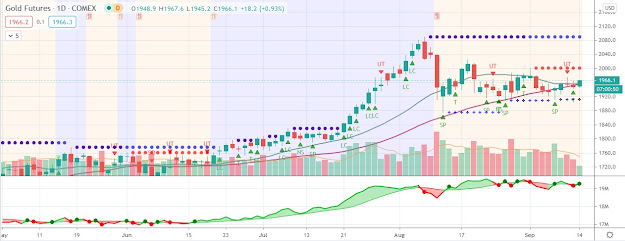Gold price will average $1,875 per ounce in the fourth quarter of 2011 and $2,000 in 2012
 The gold price surged Monday morning, rising $37.50 to $1,718 per ounce. Rumors that the International Monetary Fund (IMF) was preparing a €600 billion ($801 billion) rescue package for Italy, combined with strong retail sales in the U.S. over the weekend, helped fuel a potent rally in the stocks, commodities, and the price of gold. S&P 500 stock futures, which gained 33.20 to 1186.60, have fallen for seven consecutive trading sessions heading into the day. WTI crude oil rose 2.9% to $99.58 per barrel while copper advanced 2.7% to $3.37 per pound.
The gold price surged Monday morning, rising $37.50 to $1,718 per ounce. Rumors that the International Monetary Fund (IMF) was preparing a €600 billion ($801 billion) rescue package for Italy, combined with strong retail sales in the U.S. over the weekend, helped fuel a potent rally in the stocks, commodities, and the price of gold. S&P 500 stock futures, which gained 33.20 to 1186.60, have fallen for seven consecutive trading sessions heading into the day. WTI crude oil rose 2.9% to $99.58 per barrel while copper advanced 2.7% to $3.37 per pound.Commenting on the outlook for gold prices, Barclays Capital precious metal analyst Suki Cooper predicted in a recent Bloomberg interview that the gold price will average $1,875 per ounce in the fourth quarter of 2011 and $2,000 in 2012. However, she also stated that “In the near term prices look a little soft on the downside, but we still remain positive longer-term.”
Cooper attributed her bullish forecast to ongoing worries about the state of the global economy, which will continue to “support investor interest” in the yellow metal. She noted that physical demand for gold has been on the rise of late, and that “gold ETF flows picked up in October and this has continued into November.”
Looking ahead to the coming week, sovereign debt turmoil in Europe is likely to be a key driver for the gold price. German Chancellor Angela Merkel and French President Nicolas Sarkozy are scheduled to meet on December 9, at a summit to discuss potential changes to the European Union treaty. These changes could allow for a more robust set of measures to assist the European banking system and several of the PIIGS countries.
In the U.S., the economic calendar this week is particularly heavy with data that is likely to impact the price of gold. New home sales for October are due out on Monday, along with by the Case-Shiller report on home prices and Consumer Confidence reports on Tuesday. ADP employment data will be released Wednesday morning, followed by the Fed’s Beige Book in the afternoon. Weekly jobless claims are scheduled for Thursday, as well as the ISM Index, a key gauge of manufacturing activity. The most critical economic data point for the markets, however, will occur on Friday with the November non-farm payrolls report. If the data misses economists’ estimates, gold prices are likely to remain well supported, while a better than expected report could provide a headwind for the yellow metal.



Comments
Post a Comment